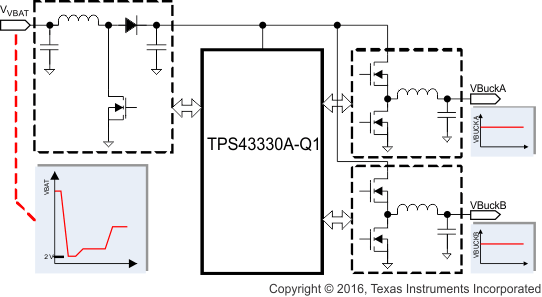SLVSC16B August 2013 – July 2016 TPS43330A-Q1
PRODUCTION DATA.
- 1 Features
- 2 Applications
- 3 Description
- 4 Revision History
- 5 Pin Configuration and Functions
- 6 Specifications
-
7 Detailed Description
- 7.1 Overview
- 7.2 Functional Block Diagram
- 7.3 Feature Description
- 7.4
Device Functional Modes
- 7.4.1
Buck Controllers: Normal Mode PWM Operation
- 7.4.1.1 Frequency Selection and External Synchronization
- 7.4.1.2 Enable Inputs
- 7.4.1.3 Feedback Inputs
- 7.4.1.4 Soft-Start Inputs
- 7.4.1.5 Current-Mode Operation
- 7.4.1.6 Current Sensing and Current Limit With Foldback
- 7.4.1.7 Slope Compensation
- 7.4.1.8 Power-Good Outputs and Filter Delays
- 7.4.1.9 Light-Load PFM Mode
- 7.4.1
Buck Controllers: Normal Mode PWM Operation
-
8 Application and Implementation
- 8.1 Application Information
- 8.2
Typical Application
- 8.2.1 Design Requirements
- 8.2.2
Detailed Design Procedure
- 8.2.2.1 Boost Component Selection
- 8.2.2.2 Boost Maximum Input Current IIN_MAX
- 8.2.2.3 Boost Inductor Selection, L
- 8.2.2.4 Inductor Ripple Current, IRIPPLE
- 8.2.2.5 Peak Current in Low-Side FET, IPEAK
- 8.2.2.6 Right Half-Plane Zero RHP Frequency, fRHP
- 8.2.2.7 Output Capacitor, COUTx
- 8.2.2.8 Bandwidth of Boost Converter, fC
- 8.2.2.9 Output Ripple Voltage Due to Load Transients, ∆VOUTx
- 8.2.2.10 Selection of Components for Type II Compensation
- 8.2.2.11 Input Capacitor, CIN
- 8.2.2.12 Output Schottky Diode D1 Selection
- 8.2.2.13 Low-Side MOSFET (BOT_SW3)
- 8.2.2.14 BuckA Component Selection
- 8.2.2.15 Inductor Selection L
- 8.2.2.16 Inductor Ripple Current IRIPPLE
- 8.2.2.17 Output Capacitor COUTA
- 8.2.2.18 Bandwidth of Buck Converter fC
- 8.2.2.19 Selection of Components for Type II Compensation
- 8.2.2.20 Resistor Divider Selection for Setting VOUTA Voltage
- 8.2.2.21 BuckB Component Selection
- 8.2.2.22 Resistor Divider Selection for Setting VOUT Voltage
- 8.2.2.23 BuckX High-Side and Low-Side N-Channel MOSFETs
- 8.2.3 Application Curves
- 8.3 System Examples
- 9 Power Supply Recommendations
- 10Layout
- 11Device and Documentation Support
- 12Mechanical, Packaging, and Orderable Information
パッケージ・オプション
メカニカル・データ(パッケージ|ピン)
- DAP|38
サーマルパッド・メカニカル・データ
- DAP|38
発注情報
1 Features
- Qualified for Automotive Applications
- AEC-Q100 Qualified With the Following Results:
- Device Temperature Grade 1: –40°C to +125°C Ambient Operating Temperature
- Device HBM ESD Classification Level H2
- Device CDM ESD Classification Level C2
- Two Synchronous Buck Controllers
- One Pre-Boost Controller
- Input Range up to 40 V, (Transients up to 60 V), Operation Down to 2 V When Boost is Enabled
- Low-Power-Mode IQ: 30 µA (One Buck On), 35 µA (Two Bucks On)
- Low Shutdown Current: Ish < 4 µA
- Buck Output Range 0.9 to 11 V
- Boost Output Selectable: 7 V, 8.85 V, or 10 V
- Programmable Frequency and External Synchronization Range 150 to 600 kHz
- Separate Enable Inputs (ENA, ENB, ENC)
- Selectable Forced Continuous Mode or Automatic Low-Power Mode at Light Loads
- Sense Resistor or Inductor DCR Sensing for Buck Controllers
- Out-of-Phase Switching Between Buck Channels
- Peak Gate-Drive Current: 1.5 A
- Thermally Enhanced 38-Pin HTSSOP (DAP) PowerPAD™ Package
2 Applications
- Automotive Start-Stop, Infotainment, Navigation Instrument Cluster Systems
- Industrial and Automotive Multi-Rail DC Power Distribution Systems and Electronic Control Units
3 Description
The TPS43330A-Q1 device includes two current-mode synchronous-buck controllers and a voltage-mode boost controller. The device is ideally suited as a pre-regulator stage with low IQ requirements and for applications that must survive supply drops due to cranking events. The integrated boost controller allows the device to operate down to 2 V at the input without seeing a drop on the buck regulator output stages. At light loads, the buck controllers enable to operate automatically in low-power mode, consuming just 30 µA of quiescent current.
The buck controllers have independent soft-start capability and power-good indicators. Current foldback in the buck controllers and cycle-by-cycle current limitation in the boost controller provide external MOSFET protection. The switching frequency is programable over 150 to 600 kHz or is synchronized to an external clock in the same range.
Device Information(1)
| PART NUMBER | PACKAGE | BODY SIZE (NOM) |
|---|---|---|
| TPS43330A-Q1 | HTSSOP (38) | 12.50 mm × 6.20 mm |
- For all available packages, see the orderable addendum at the end of the data sheet.
